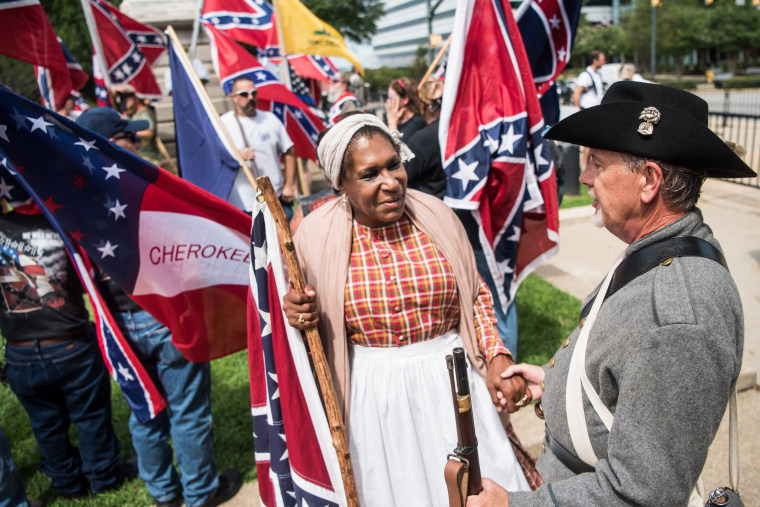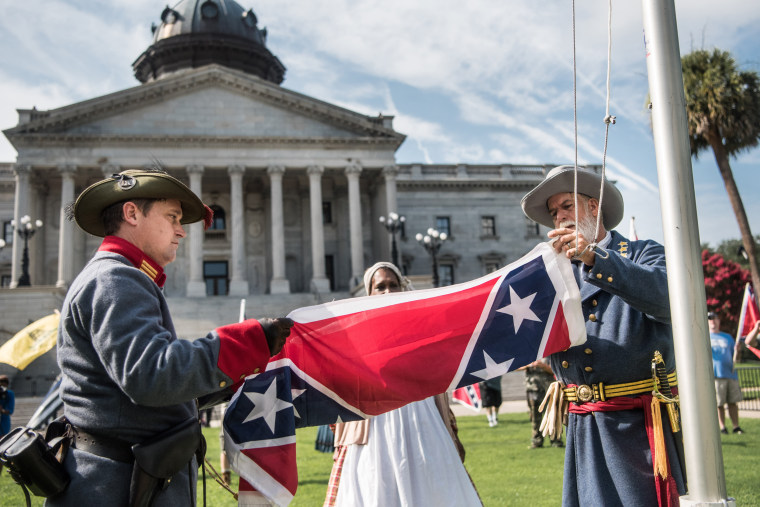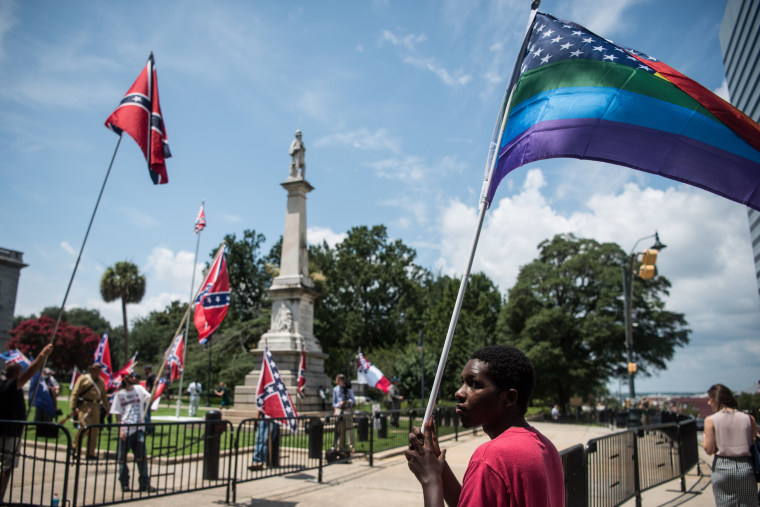The Confederate battle flag was raised outside the South Carolina Statehouse again Monday, but it rose on a pole that was planted in a temporary plastic stand — not in the earth.
The ceremony was timed to mark the second anniversary of the state’s decision to remove a Civil War banner that for many white southerners was an emblem of pride — and a symbol of racism to just about everybody else.
But the flag-raising was also a protest against recent moves by lawmakers in Southern cities like New Orleans and elsewhere to remove Confederate monuments from the public areas where they have stood for decades.
“They are trying to demonize and vilify our ancestors 150 years after their deaths,” South Carolina Secessionist Party president James Bessenger insisted.
His words were met with derision from the demonstrators who far outnumbered the two-dozen or so flag supporters, some of whom showed up wearing replicas of the Confederate gray uniforms of their forefathers.
“Go home, you’re not wanted here,” one protester cried out. “You lost then and you’ll lose again. Go home Confederates!”

The flag was raised by a white Secessionist party member dressed in a Confederate uniform named Braxton Spivey and a black woman named Arlene Barnum.
Barnum, who was wearing the kind of frock that many slaves wore during the Civil War, has become a fixture at pro-Confederate rallies. She was in New Orleans in April to protest the removal of the Jefferson Davis statue. And she stuck to the South Carolina Secessionist Party line that the war was not fought to end slavery.
“I’m so sick of that damn word slavery,” she said.
South Carolina began flying the flag over the dome of the Capitol in Columbia in 1961 to celebrate the 100th anniversary of the war. But instead of removing it after the anniversary passed, the white politicians who ran the state kept flying it in defiance of the Civil Rights struggle that was underway.

In 2000, it was removed from the dome and moved to the grounds as part of a compromise reached with Democratic black lawmakers.
But the struggle to banish it altogether continued.
Then in June 2015 an avowed racist named Dylann Roof murdered nine worshippers at a historic African-American church in Charleston, South Carolina and the drive to remove the flag got the support from politicians who had previously opposed such a move, like then-Gov. Nikki Haley.
And the next month, the flag was finally lowered and dispatched to the nearby Confederate Relic Room and Museum.
Asked for comment about the flag raising, the South Carolina Department of Administration said in a statement that the South Carolina Secessionist Party “followed the appropriate process for reserving a section of the grounds to hold an event.” It noted that while groups are allowed to display flags they “cannot be left unattended and cannot be maintained by staking items into the ground.”
“The South Carolina Secessionist Party or any other private group is not permitted to fly the Confederate Flag or any other flag over the State House or from a state flagpole,” the statement read.
And it must be removed by 5 p.m.

Historian W. Fitzhugh Brundage at the University of North Carolina said Southerners have "long nurtured this sense of the Confederate tradition being under threat" and many view the removal of their flag as proof that their worst fears were coming true.
"The Charleston church massacre intensified the rhetoric about removing Confederate symbols from public spaces," he said. "After the Dylann Roof shooting, it went from, 'Why are they still flying the flag?' to 'Why are there still so many Confederate monuments on our landscape?'"
Kevin Levin, another expert on the Civil War, agreed that "Roof is commonly cited as a catalyst" for removing the Confederate flag. But he said the removal of other Confederate symbols from public spaces has gained steam as African-Americans gained more political power.
"Once you have more African-Americans on city councils, elected as mayors, you have a change in the conversation about how history is remembered," he said.
As for critics who say removing these statues is tampering with history, Levin said, "Few Americans would question the decision by the Poles or the Czechs to remove statues of Lenin or Soviet soldiers from their territory."
In addition to New Orleans, the other cities seeking to mothball monuments to the Confederacy include Baltimore and Charlottesville, Virginia, where a couple dozen KKK members protesting the planned removal of a General Robert E. Lee statue got an earful over the weekend from ten times as many counter-protesters.
In Richmond, Virginia, the city's African-American mayor, Levar Stoney, has created a commission to help find a way of placing the memorials to Davis and Lee on Monument Avenue in the proper historical context rather than truck them away.
In Norfolk, Virginia, a memorial to the Confederate war dead was vandalized by somebody who spray painted the word "Shame." And in Tampa, Florida, the bid to remove the 106-year-old Confederate monument outside the old courthouse was stymied last month when the Republican-led Hillsborough County Commission voted 4-3 to keep it there.
There is now a move afoot to move the statue to a historic Tampa cemetery.
Meanwhile, Alabama went in the opposite direction. The governor in May signed a law that provides sweeping protections for Confederate monuments and other memorials.

